This was published 6 years ago
The Mandarin Oriental, Hong Kong: Jet set glamour lives on
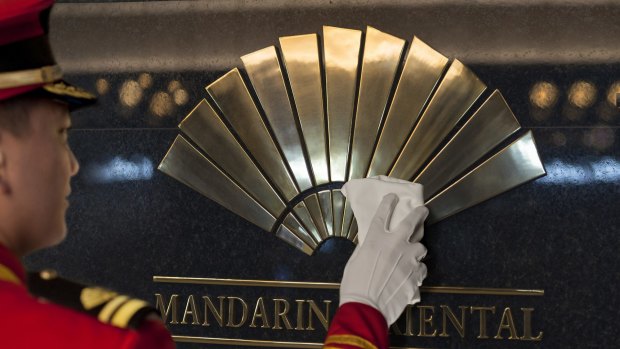
Hong Kong's Mandarin Oriental retains some of the glamour that made it a favourite of the jet set.Credit: Getty Images
My arrival at the Mandarin Oriental Hong Kong is characterised by the kind of carefully organised chaos that makes a visit to a big, buzzing classic Asian five-star hotel unlike that of any other part of the world. I'm whisked from the limo-laden driveway to inside by the commissionaire, or doorman, if you will, with all of the haste and skill of a Kardashian bodyguard.
Safely indoors, my luggage having been whisked away by a porter, to be dispatched to my room as I attempt to negotiate my way through the crowded, low-ceilinged lobby, packed full of guests and a phalanx of immaculate black-uniformed staff zipping from one black marbled counter to another.
Miraculously, a good many of the nostalgic 19th and early 20th century colonial-era hotels of Asia, such as Singapore's Raffles and Colombo's Galle Face, have survived. But few from more relatively recent times, like the past 50 years or so, are still operating.
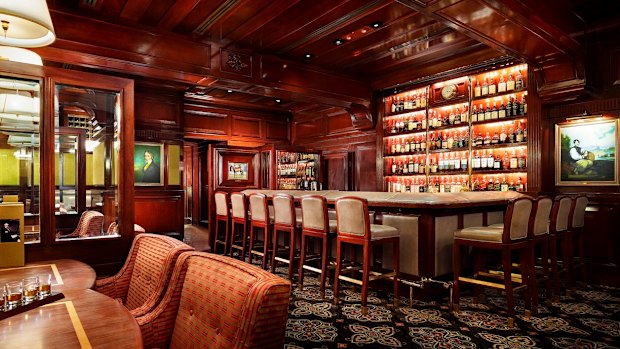
The bar retains the old-world feel of a British gentlemen's club.Credit: Getty Images
One exception is this establishment where I've just checked-in, the 434-room and 67-suite, Mandarin Oriental Hong Kong, opened in 1963, the first five-star hotel on Hong Kong Island. It was the embodiment of the glamorous, pre mass-tourism jet set era – more James Bond than Mata Hari – when compared to its dowager-like counterparts across Asia and even across Victoria Harbour at Kowloon where The Peninsula stands.
The Mandarin, as it was known back then, opened in the era when travel was genuinely exciting, not tedious – and, as recent events have shown, at times confrontational – pursuit. When it first opened, Hong Kong was a more exotic place at the emerging cosmopolitan crossroads of the jet set, with the 27-storey Mandarin Oriental once dominating the Victoria Harbour waterfront.
Many of the great colonial era hotels may still have been trading across Asia in the late 1950s and 1960s. However, as author Nigel Cameron points out in his book, The Mandarin – Hong Kong, that with the exception of the Frank Lloyd Wright-designed Imperial in Tokyo, they compared unfavourably to the grand hotels in the west.
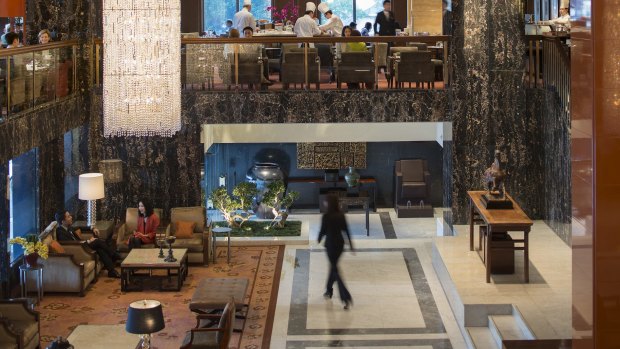
Glitz and glamour.Credit: Getty Images
"All were old and most in rather less than first-class condition," Cameron writes, "having survived [World War II] after which little was done to upgrade them."
Now what is perhaps the youngest of Asia's colonial era grand hotels is the venerable flagship of an eponymous group that extends around the world. It opened, after all, a full 34 years before the British handover of Hong Kong to the Chinese in 1997. When it was ready to accept its first guests in 1963, it was the tallest building on the island and the first hotel in Hong Kong to feature direct-dial telephones and a bathtub in every room. Today, however, from the opposite shore of Hong Kong's fragrant and frenetic harbour, it tends to resemble the smallest box on a chocolatier's shelf, dwarfed as it is by the likes of Norman Foster's masterpiece 47-storey high Hong Kong & Shanghai Bank Building complex behind it.
It didn't take long for the hotel to establish a formidable reputation, and for it to help establish Hong Kong as a capital of the jet set, with the US-based Fortune magazine declaring it among the few dozen great hotels of the world alongside the likes of the Connaught in London, the Imperial in Vienna and the Dolder Grand in Zurich.
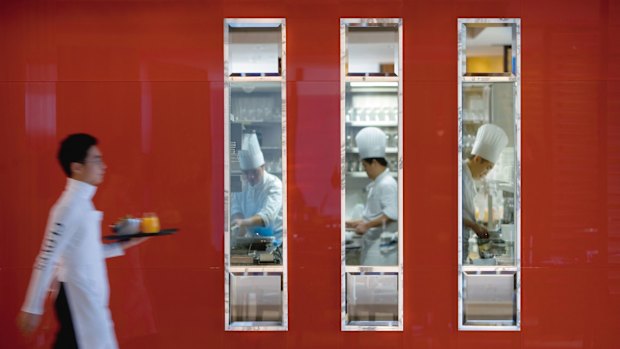
Chefs hard at work.Credit: Getty Images
All of those hotels are powerfully emblematic of their cities, a quality not lost on Peter Stafford, a former general manager of the hotel, who once remarked that "a hotel must always be in some ways a reflection of the best things in the city or the country, ... [at the Mandarin Oriental Hong Kong] the guests know where they are – in Hong Kong, in the east [whether it be] in a bedroom or a restaurant."
Yet when the inevitable time came in over a decade ago to commit to a major refurbishment of the hotel, the owners were presented with the challenge of modernising and updating the hotel without losing it 1960s jet set appeal. Its low-ceilinged lobby, leading to a more expansive lounge area, was retained for one of the original dining establishments, the Chinnery, named after the British artist, George Chinnery, who spent much of his life in southern China.
In less politically correct times, the Chinnery would have been described as a gentlemen's club, what with its deep, upholstered armchairs, mandatory green leather banquettes and wood panelling. A fog of cigar and cigarette fumes would no doubt have pervaded the place.
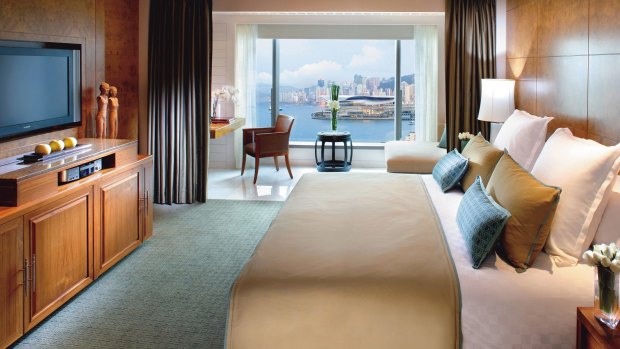
Spectacular views across the harbour.Credit: Getty Images
One of the first things the Chinese did when they took back Hong Kong was to change the red British post-boxes to green but at the Chinnery, home to one of the world's largest collection of single-malt whiskies, they're still serving traditional British dishes such as shepherd's piece and fish and chips – though on my visit I opt for the old-fashioned chicken curry.
But some traditions remain, with prospective patrons of the Chinnery reminded that "after 5pm, ladies are kindly asked to wear elegant attire and proper footwear" and "gentlemen are kindly asked to wear closed shoes at all times with smart short and long trousers after 5pm".
A favourite feature of the hotel is its old-fashioned kiosk – not much bigger than a phone box and something that designers no longer tend to include in modern-day hotels – stuffed with a wonderful selection of international and local newspapers, magazines and books. It's from there I buy a copy of A Stroll Through Colonial Hong Kong. When I later leave it open on the bed I return to find a bookmark in the spot I'd left.
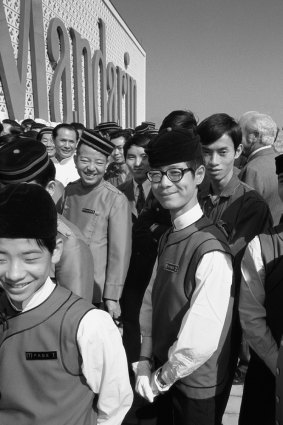
Back in the early days.Credit: Getty Images
I guess you have to wonder whether a structure of the 1960s, without the good bones of the venerable Raffles Singapore, the Taj Mahal in Mumbai or its rival, the Peninsula Hong Kong across the harbour, can possibly survive another 50 years. But, for the time-being, while the jet set may have disappeared like the an airliner vapour trail, a prospective guest can be assured of still finding some authentic traces of the glamour that distinguished that era of travel inside the Mandarin Oriental Hong Kong.
FIVE MORE MODERN CLASSIC HOTELS OF THE WORLD
RADISSON BLU ROYAL HOTEL, COPENHAGEN
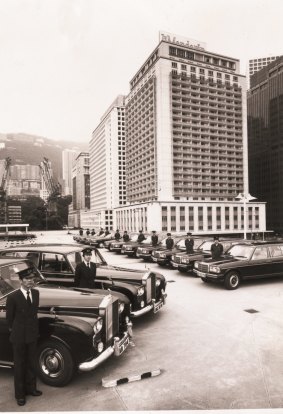
Drivers await.Credit: Getty Images
Designed by Arne Jacobsen, the iconic Danish architect and designer on behalf the airline Scandinavian Airlines System (SAS) between 1956 and 1960, this hotel remains the epitome of the mid-century modern jetset. Jacobsen's classic swan and egg chairs dominate the lobby. See radissonblu.com/en/royalhotel-copenhagen.
MANDARIN ORIENTAL, BANGKOK
Similarly to the Imperial Hotel, Tokyo, this esteemed sister property of the Mandarin Oriental Hong Kong dates to the second half of the 19th century. But in 1958, a modern 10-storey Garden Wing was added, featuring the Thai capital's first elevator, and which to this day forms the basis of the hotel's main lobby. See mandarinoriental.com/bangkok.
IMPERIAL HOTEL, TOKYO
Although it opened in 1890, many parts of this 931-room hotel, located close to the Japanese capital's centrepiece Imperial Palace ando its gardens, were built were built between the 1950s and 1960s. Two, since sadly demolished, structures having been designed by Frank Lloyd Wright. Today, the hotel exudes a certain austere urbanity. See imperialhotel.co.jp.
TAJ MAHAL PALACE HOTEL, MUMBAI
The quintessential Bombay bolthole, the Taj Mahal Palace Hotel is most famous for its early 20th century heritage building. But the hotel also features a tower that in 1973 wasp opened as an additional wing. In this modern part of the hotel there is a poignant memorial to staff and guests slaughtered in the 2008 terrorist attack. See taj.tajhotels.com.
SOFITEL WENTWORTH, SYDNEY
Originally commissioned by Qantas, which was headquartered in a landmark building on the same street, the Wentworth was once the biggest brick building in the southern hemisphere. Even though it was opened in 1966 it is Sydney's oldest major international hotel. It was Qantas' belief at the time that "the tremendous speed and capacity of modern jet aircraft had made it essential for Qantas to have its own first-class hotel accommodation".
TRIP NOTES
MORE
FLY
Cathay Pacific operates over 70 flights a week to Hong Kong from six major Australian cities. There are four flights daily from Sydney and three daily from Melbourne. See cathaypacific.com/au.
STAY
Mandarin Oriental Hong Kong, 5 Connaught Road, Hong Kong. See mandarinoriental.com. Doubles from HKD3230
Anthony Dennis visited as as a guest of the Hong Kong Tourism Board, Cathay Pacific and the Mandarin Oriental Hong Kong.
Sign up for the Traveller newsletter
The latest travel news, tips and inspiration delivered to your inbox. Sign up now.